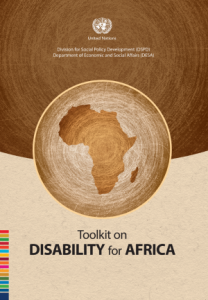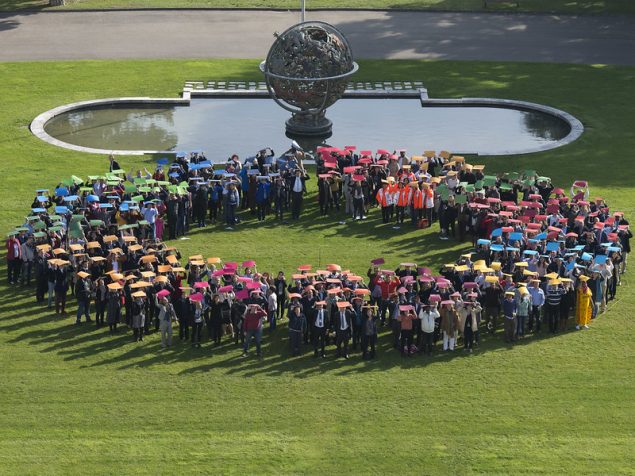- Main page: Handbook for Parliamentarians
- Realizing the rights of persons with disabilities: the compelling reasons
- The focus of the Convention
- Why a convention was needed
- Rights specified in the Convention
- The relationship between disability and development
THE RELATIONSHIP BETWEEN DISABILITY AND DEVELOPMENT
Once a country ratifies the Convention, the obligations established by the Convention must be reflected in the State’s national legal framework, development planning and budgeting, and in related policies. The Convention highlights the concrete, pragmatic steps that States Parties should take to support the inclusion of persons with disabilities into all areas of development (see chapter 5).
The Convention also recognizes the importance of international development cooperation in supporting national implementation efforts. For the first time, the Convention shifts emphasis away from creating specialized programmes for persons with disabilities, such as rehabilitation, to requiring that all development programmes, including those supported through international cooperation, be inclusive and accessible to persons with disabilities. And in all instances, organizations of persons with disabilities should participate in formulating these development programmes.
The need to include persons with disabilities in the world’s development mainstream is evident, particularly with regard to the Millennium Development Goals. Without their participation, it will be impossible to halve the incidence of poverty and hunger by 2015, as envisioned in millennium development goal 1 (see box below). Similarly, the right to free and universal primary education for every child (millennium development goal 2) will not be achieved as long as 98 per cent of children with disabilities in developing countries do not attend school.
At the United Nations Millennium Summit in September 2000, Heads of State and Government agreed to work to achieve the following Goals:
Goal 1 – Eradicate extreme poverty and hunger
Poverty as a cause of disability: well over 50 per cent of disabilities are preventable and directly linked to poverty. This is particularly true for disabilities arising from malnutrition, maternal undernourishment and infectious diseases.
Disability as a risk factor for poverty: over 85 per cent of persons with disabilities live in poverty.
Goal 2 – Achieve universal primary education
An estimated 98 per cent of children with disabilities in the developing world do not attend school.
Goal 3 – Promote gender equality and empower women
It is widely recognized that women with disabilities are doubly disadvantaged in society: they are excluded from various activities because of both their gender and their disability.
Women with disabilities are twice to three times more likely to be victims of physical and sexual abuse than women without disabilities.
Goal 4 – Reduce child mortality
Mortality rates for children with disabilities can be as high as 80 per cent in some countries, even in those countries where mortality rates among children who have no disabilities is below 20 per cent.
Goal 5 – Improve maternal health
Approximately 20 million women become disabled each year as a result of complications during pregnancy or childbirth.
Abnormal prenatal events are a major cause of disability in children in the developing world. Such disabilities can often be prevented.
Goal 6 – Combat HIV/AIDS, malaria and other diseases
Persons with disabilities are particularly vulnerable to HIV/AIDS but typically lack the necessary services and access to information on prevention and treatment.
One in 10 children has a neurological impairment, including learning disabilities and loss of coordination and epilepsy, as a consequence of malaria.
Goal 7 – Ensure environmental sustainability
Poor environmental quality is a significant cause of ill health and disability.
Trachoma is the main cause of preventable blindness and can be prevented with access to safe water.
Goal 8 – Develop a global partnership for development
Most persons with disabilities do not have access to new technologies, especially information and communications technology (ICT). The majority of websites are inaccessible and assistive technology is too expensive.
CHECKLIST FOR PARLIAMENTARIANS
Why I should be interested in the rights of persons with disabilities
- The human rights of persons with disabilities should be promoted for the same reason that human rights are promoted for all other people: because of the inherent and equal dignity and worth of each human being.
- In most countries, persons with disabilities have difficulty attending school, getting a job, voting and obtaining health care.
- The only way to ensure that persons with disabilities can fully enjoy their human rights is to guarantee those rights under national law, support that legislation through consistent, coordinated and continued actions across all ministries, and ensure that legal institutions enforce respect for those rights.
- Marginalizing persons with disabilities and encouraging them to remain dependent is costly, both for their families and for the general public. Empowering persons with disabilities to live independently and contribute to society is socially and economically beneficial.
- Everyone is likely to experience disability at some point during his/her lifetime because of illness, accident or ageing.
- Persons with disabilities are voters, taxpayers and citizens like everyone else. They expect your support and are fully entitled to it.
Next – Chapter Two: The Convention in detail – Historical developments leading to a new convention




